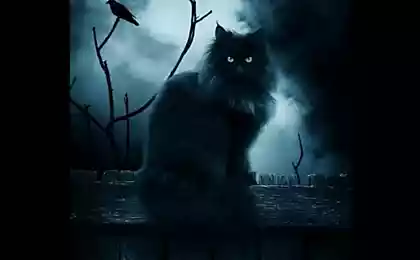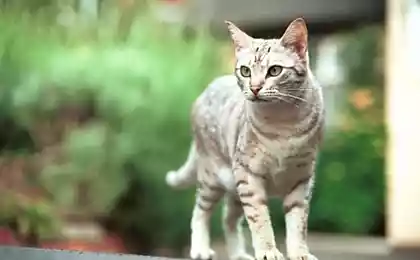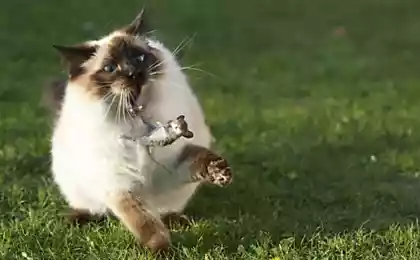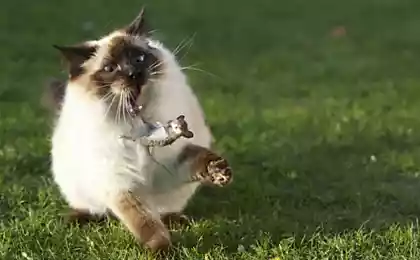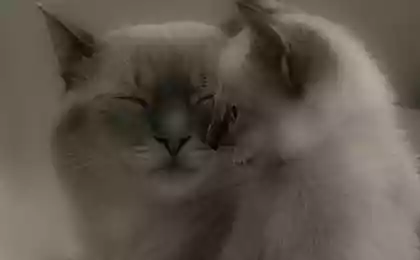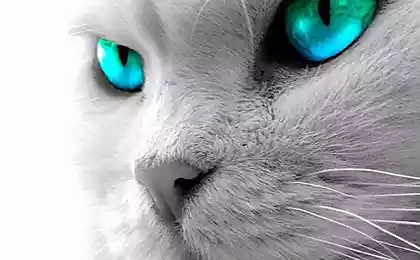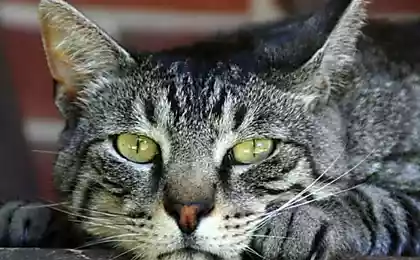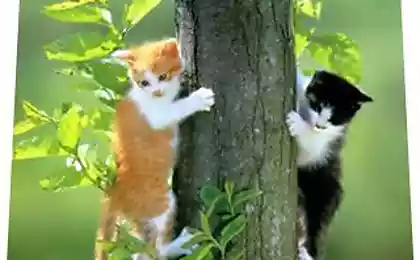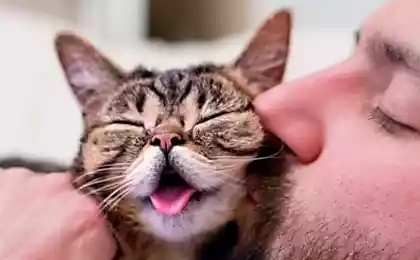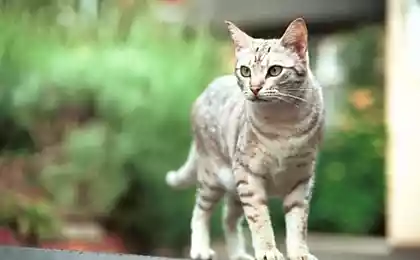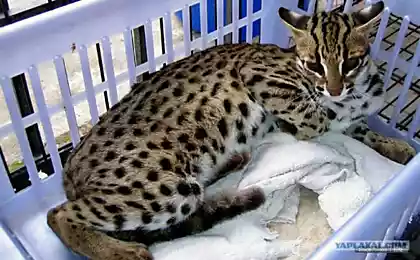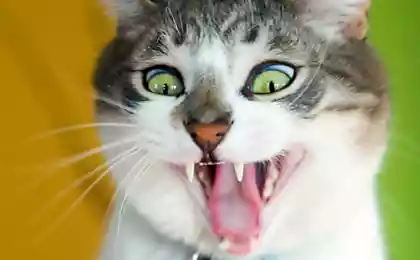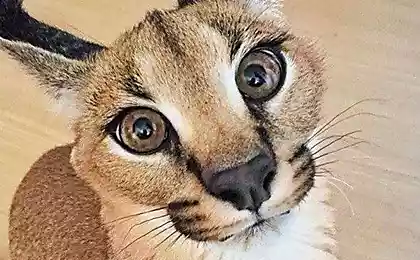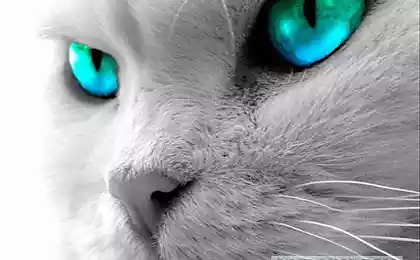984
Kotofakty (Letters + 3 photos)
Cat lovers devoted ... just the facts ... kotofakty!
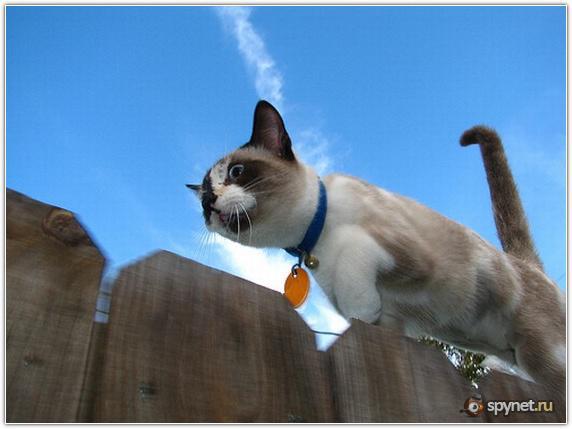
* Skeleton cat consists of 230 bones, 24 bones is greater than that of human
* Cats have no collarbone normal. Due to this lack of a cat can push through your body through very small holes, which passes the cat's head. You may have seen a cat check hole, where she has to climb, trying to bore his head. The average adult cat can climb through the hole, for example, a fence, a width of 10 cm.
* Cat - a great acrobat. Its front legs can rotate in almost any direction, and the two halves of her body can move in opposite directions!
* Cats have five toes on their front paws, but rear - only four.
* A cat's ear is rotated 180 degrees. In each ear of a cat 32 muscle to control the ear they use twelve or more muscles.
* Hearing a cat is much more sensitive than a human or a dog. Cat hears within 65 kHz, while the people - in the range of 20 kHz.
* A cat can hear sounds in the ultrasonic range, and its "ambush" about a mouse mink makes sense, even if the rodents are moving. Rodents communicate using ultrasound and cat these conversations overheard.
* On the head and front legs cats are tactile hairs - they help the cat does not lose orientation in space, and focuses cat without touching these hairs with obstacles and feeling them at a distance.
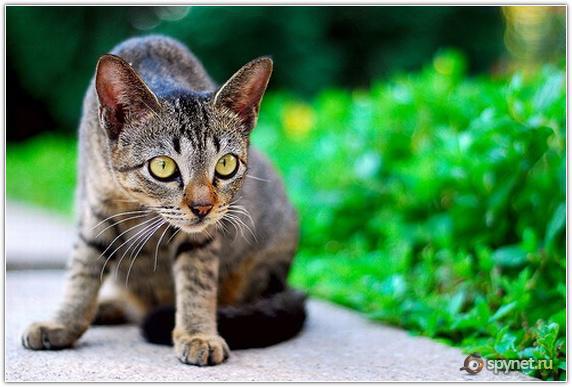
* With respect to the weight of his body has the largest cat eyes of all animals. If the cat was the size of a person, the size of her eyes would reach 4-5 cm.
In tarsier each eye weighs more than his mozg.No of all kinds, it is on this basis, the record is Philippine tarsier. Yes, and in general, the Philippine tarsier - the owner of the largest eyes of any mammal (Amendment of asket_815)
* The majority of cats are no eyelashes.
* The eyes of cats are arranged so that both facing the same direction, just as we have (in contrast, for example, dogs) - for us it is more usual type of person, maybe that's why we believe these cats cute animals?
* A cat can not see in total darkness, but her "night vision" out of competition. Her eyes have a reflective layer, which increases the amount of light hitting the retina.
* Under favorable conditions, green cat eyes visible at a distance of up to 80 meters due to the fact that the cat's eyes reflect light, so that part of the beam returns along the same path by which they came into the eyes.
* Binocular vision cat covers 130 degrees (the dog - 83). But the cat is also able to observe everything that is happening on the sides! Her visual field of 287 degrees compared to our 200. Extremely movable head is spinning in all directions and allows you to constantly maintain direct gaze.
* A cat does not see anything right under his nose. That's why it is not immediately on the floor tidbit that you gave her.
* A cat from about 60 to 80 million olfactory cells in humans - from 5 to 20 million.
* Compared to lyudtmi cats certainly have highly developed sense of smell. In relation to the total volume of that part of the brain that is responsible for the sense of smell, the cat is much more. This allows it to easily distinguish individuals or identify the smell mark that she herself had previously visited that particular place. It was the smell of males recognize the cat, which is so coveted mating scent that stands out in the urine attracting females.
* Cats, like people, can have the blood group AB.
* Normal pulse cat 110-170 beats per minute, breathing - 20-40 breaths per minute. The normal body temperature of cats - 102 degrees Fahrenheit (38 Celsius)

* Domestic cat can run at a speed of 31 miles per hour.
* The cat is very sensitive nervous system.
* A cat can jump high, 5 times higher than its growth. The imprint of the nose of each cat is unique, no two identical fingerprints. American scientists were able to see the world through the eyes of a cat. Scientists have conducted a brain cat electrodes, which were connected with 177 neurons. Read and decode the signals from the electrodes, the computer shows the display picture that sees the cat. The picture was blurred, but it can be quite clearly distinguish different objects and faces. Other US researchers found that cats, unlike dogs, saturate the air with negative ions that are beneficial to human health. The cat 50 thousand genes, which are distributed over 19 pairs of chromosomes.
* Cats gene responsible for red hair color is attached to the floor of the animal, and belongs to one of the X chromosomes. This gene can produce red or black. Thus, a cat with two X chromosomes and can wear red and black colors in her hair. Côte same with only one X chromosome, can be either black or red, but not both simultaneously.
* If the cat still has both red and black color (this occurs very rarely), it will be sterile. The fact that this must have both a cat or female portion of both X-chromosome. This unusual combination of chromosomes and causes that the animal is sterile.
* When the kittens are born, their eyes and ears closed. When the eyes open, they are always blue at first. Then, with time, they change color to a constant.
* Kittens baby teeth appear in 10-30 day. In the period from 4 to 10 months, they are changed to permanent. The amount which the adult animal should be 30. A cat is considered to be an adult with 15 months of age.
* Healthy adult cats for about 15% of their lives in a deep sleep, 50% - in a superficial dream and only 35% - are awake.
* Daily cat toilets are explained not only by its cleanliness. Another goal of "washing" - a lick of wool a certain amount of substance containing vitamin B, which is necessary for the regulation of mental equilibrium. If you deprive your cat of this opportunity, it will become nervous and may even die.
* Addicted to mice, cats have a physiological explanation: in the wool mice a lot of sulfur, which is a must for cats, not to be bald.
* Cats have one thing in common with giraffes and camels - they "pacers": first at the same time raise the right front and hind legs, and then also at the same time - the left. In addition, cats - the only animals that do not rely on walking on the pads, and claws.
* 25% of all cats and dogs ambidexters (ie they are equally good command of the right and left paw)
* Cats have no fat and sweat glands, so it does not smell. They sweat just ends leathery feet.
* As is well known, the nature of man and animals took the most different life spans. Meanwhile, youth, maturity and old age are common to all living beings. Naturally, in the arrival time of a particular age will vary depending on the species. Thus, the monthly kitten is in the same stage of development as a human child of 5-6 months of age. The six-month cat "coeval" seventh graders (14 years) and fourteen - semidesyatidvuhletnego old.
* Cats began to live longer. If in 1930 they were on average "eyesore" to their masters for 8 years, and now they need to "hate" has 16 same old cat named Puss in the world (in Russian Keys) - he died in America before their day after Party on the occasion of its thirty-sixth birthday.
* Under the skin withers kitten are nerve endings that cause spetsifichesekoe behavior - "reflex withers" - when the body relaxes kitten, and his tail and legs are pressed to the tummy that would not catch on until it is transported.
* Forepaws kittens grow faster than the rear, but by the end of the third week, they equalized in the development, however, they are poorly coordinated with each other - so it seems that the rear and front paws of a kitten go in different directions.
* On the third week, the kittens begin to erupt baby teeth - this process takes up to 6 weeks. But starting with a 3-month old roots of these first teeth begin to dissolve, the crown - to drop out, and 30 new adult (permanent) teeth come in to replace them.
* A cat can watch right in several mouse burrows and catch the subtle movements of mice. Field of cats - 187 degrees, the dog is two times less, and a man - and a half times less.
* Cats use when communicating over a hundred different sounds, surpassing in this dog, chimpanzee and gorilla.
Here is my collection of photos of cats with a junction (rar, 85 MB):
Koshke.rar - klatsat

* Skeleton cat consists of 230 bones, 24 bones is greater than that of human
* Cats have no collarbone normal. Due to this lack of a cat can push through your body through very small holes, which passes the cat's head. You may have seen a cat check hole, where she has to climb, trying to bore his head. The average adult cat can climb through the hole, for example, a fence, a width of 10 cm.
* Cat - a great acrobat. Its front legs can rotate in almost any direction, and the two halves of her body can move in opposite directions!
* Cats have five toes on their front paws, but rear - only four.
* A cat's ear is rotated 180 degrees. In each ear of a cat 32 muscle to control the ear they use twelve or more muscles.
* Hearing a cat is much more sensitive than a human or a dog. Cat hears within 65 kHz, while the people - in the range of 20 kHz.
* A cat can hear sounds in the ultrasonic range, and its "ambush" about a mouse mink makes sense, even if the rodents are moving. Rodents communicate using ultrasound and cat these conversations overheard.
* On the head and front legs cats are tactile hairs - they help the cat does not lose orientation in space, and focuses cat without touching these hairs with obstacles and feeling them at a distance.

* With respect to the weight of his body has the largest cat eyes of all animals. If the cat was the size of a person, the size of her eyes would reach 4-5 cm.
In tarsier each eye weighs more than his mozg.No of all kinds, it is on this basis, the record is Philippine tarsier. Yes, and in general, the Philippine tarsier - the owner of the largest eyes of any mammal (Amendment of asket_815)
* The majority of cats are no eyelashes.
* The eyes of cats are arranged so that both facing the same direction, just as we have (in contrast, for example, dogs) - for us it is more usual type of person, maybe that's why we believe these cats cute animals?
* A cat can not see in total darkness, but her "night vision" out of competition. Her eyes have a reflective layer, which increases the amount of light hitting the retina.
* Under favorable conditions, green cat eyes visible at a distance of up to 80 meters due to the fact that the cat's eyes reflect light, so that part of the beam returns along the same path by which they came into the eyes.
* Binocular vision cat covers 130 degrees (the dog - 83). But the cat is also able to observe everything that is happening on the sides! Her visual field of 287 degrees compared to our 200. Extremely movable head is spinning in all directions and allows you to constantly maintain direct gaze.
* A cat does not see anything right under his nose. That's why it is not immediately on the floor tidbit that you gave her.
* A cat from about 60 to 80 million olfactory cells in humans - from 5 to 20 million.
* Compared to lyudtmi cats certainly have highly developed sense of smell. In relation to the total volume of that part of the brain that is responsible for the sense of smell, the cat is much more. This allows it to easily distinguish individuals or identify the smell mark that she herself had previously visited that particular place. It was the smell of males recognize the cat, which is so coveted mating scent that stands out in the urine attracting females.
* Cats, like people, can have the blood group AB.
* Normal pulse cat 110-170 beats per minute, breathing - 20-40 breaths per minute. The normal body temperature of cats - 102 degrees Fahrenheit (38 Celsius)

* Domestic cat can run at a speed of 31 miles per hour.
* The cat is very sensitive nervous system.
* A cat can jump high, 5 times higher than its growth. The imprint of the nose of each cat is unique, no two identical fingerprints. American scientists were able to see the world through the eyes of a cat. Scientists have conducted a brain cat electrodes, which were connected with 177 neurons. Read and decode the signals from the electrodes, the computer shows the display picture that sees the cat. The picture was blurred, but it can be quite clearly distinguish different objects and faces. Other US researchers found that cats, unlike dogs, saturate the air with negative ions that are beneficial to human health. The cat 50 thousand genes, which are distributed over 19 pairs of chromosomes.
* Cats gene responsible for red hair color is attached to the floor of the animal, and belongs to one of the X chromosomes. This gene can produce red or black. Thus, a cat with two X chromosomes and can wear red and black colors in her hair. Côte same with only one X chromosome, can be either black or red, but not both simultaneously.
* If the cat still has both red and black color (this occurs very rarely), it will be sterile. The fact that this must have both a cat or female portion of both X-chromosome. This unusual combination of chromosomes and causes that the animal is sterile.
* When the kittens are born, their eyes and ears closed. When the eyes open, they are always blue at first. Then, with time, they change color to a constant.
* Kittens baby teeth appear in 10-30 day. In the period from 4 to 10 months, they are changed to permanent. The amount which the adult animal should be 30. A cat is considered to be an adult with 15 months of age.
* Healthy adult cats for about 15% of their lives in a deep sleep, 50% - in a superficial dream and only 35% - are awake.
* Daily cat toilets are explained not only by its cleanliness. Another goal of "washing" - a lick of wool a certain amount of substance containing vitamin B, which is necessary for the regulation of mental equilibrium. If you deprive your cat of this opportunity, it will become nervous and may even die.
* Addicted to mice, cats have a physiological explanation: in the wool mice a lot of sulfur, which is a must for cats, not to be bald.
* Cats have one thing in common with giraffes and camels - they "pacers": first at the same time raise the right front and hind legs, and then also at the same time - the left. In addition, cats - the only animals that do not rely on walking on the pads, and claws.
* 25% of all cats and dogs ambidexters (ie they are equally good command of the right and left paw)
* Cats have no fat and sweat glands, so it does not smell. They sweat just ends leathery feet.
* As is well known, the nature of man and animals took the most different life spans. Meanwhile, youth, maturity and old age are common to all living beings. Naturally, in the arrival time of a particular age will vary depending on the species. Thus, the monthly kitten is in the same stage of development as a human child of 5-6 months of age. The six-month cat "coeval" seventh graders (14 years) and fourteen - semidesyatidvuhletnego old.
* Cats began to live longer. If in 1930 they were on average "eyesore" to their masters for 8 years, and now they need to "hate" has 16 same old cat named Puss in the world (in Russian Keys) - he died in America before their day after Party on the occasion of its thirty-sixth birthday.
* Under the skin withers kitten are nerve endings that cause spetsifichesekoe behavior - "reflex withers" - when the body relaxes kitten, and his tail and legs are pressed to the tummy that would not catch on until it is transported.
* Forepaws kittens grow faster than the rear, but by the end of the third week, they equalized in the development, however, they are poorly coordinated with each other - so it seems that the rear and front paws of a kitten go in different directions.
* On the third week, the kittens begin to erupt baby teeth - this process takes up to 6 weeks. But starting with a 3-month old roots of these first teeth begin to dissolve, the crown - to drop out, and 30 new adult (permanent) teeth come in to replace them.
* A cat can watch right in several mouse burrows and catch the subtle movements of mice. Field of cats - 187 degrees, the dog is two times less, and a man - and a half times less.
* Cats use when communicating over a hundred different sounds, surpassing in this dog, chimpanzee and gorilla.
Here is my collection of photos of cats with a junction (rar, 85 MB):
Koshke.rar - klatsat
